Warren Ellis's Blog, page 83
January 9, 2012
PREVIEW: Antony Johnston's WASTELAND #33
A century ago, a disaster known only as the Big Wet destroyed society as we know it. Half the world is now covered by poisonous, rising oceans. What dry land remains is a broken, infertile world of hard ground and harder living.
Into this world steps Michael, a scavenger who roams the wasteland, trading what he can salvage from the ruins. But Michael's latest find will change his life for ever — a machine that talks in a forgotten language, supposedly giving directions to the fabled land of A-Ree-Yass-I, where mankind's downfall began…

I wrote a foreword for a previous collection of Antony Johnston's sf comics series WASTELAND, then illustrated by Christopher Mitten, and a bit of it went like this:
I like to think of WASTELAND as having not so much a structure as a pulse.
I remember Eddie Campbell once saying that his favourite stories weren't all structure: they were found shapes, if you like, that, if visualised, would look more like a branch than an organised and orderly procession of lines. Something more like a branch, or a river. This ties in with an interview I saw with a German musician, maybe someone from NEU!, looking out at a German river and suggesting that that might have been the place when the motorik came to him, the endless pulsing heart of the new German music of the Seventies and beyond that is perhaps best captured in NEU!'s "Fur Immer" — "Forever."
WASTELAND pulses and rolls on, and the destination isn't so important when the journey is this fascinating. We discover a whole new world, a world old and broken but new to us, in stages. That's the way to roll out a world. A river of revelations. Oh, we can pause and take in the sights. Linger at a settlement, sneak into the walls of a town and tour its streets and catacombs and perhaps even prise out a few of its secrets. But the pulse rolls on, and we're moving ever forward into novelty and invention.
A lot of you know Antony, because a lot of you played the DEAD SPACE games, for which Antony has been the chief writer.
WASTELAND has a new artist, Justin Greenwood, and the next issue, #33, due out on January 18, is a new start for the series. There's no better point to discover WASTELAND. A preview of issue 33, selected and provided by Antony, can be found by clicking for more.
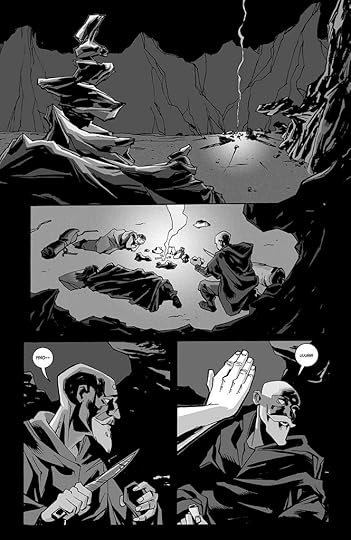
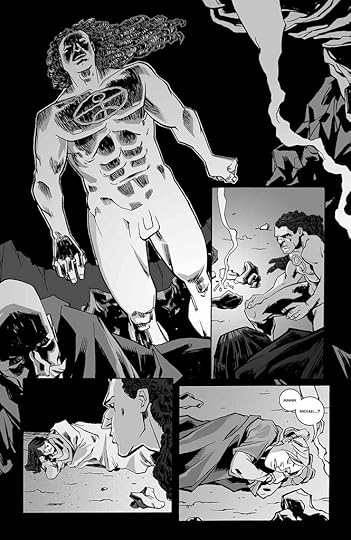


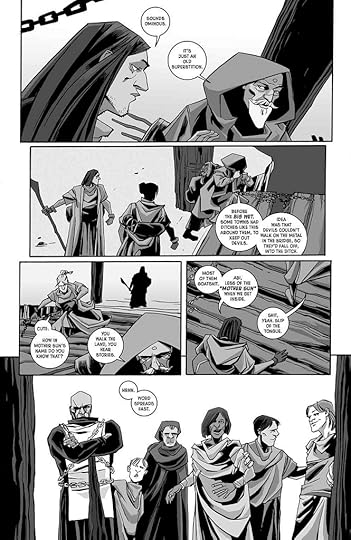
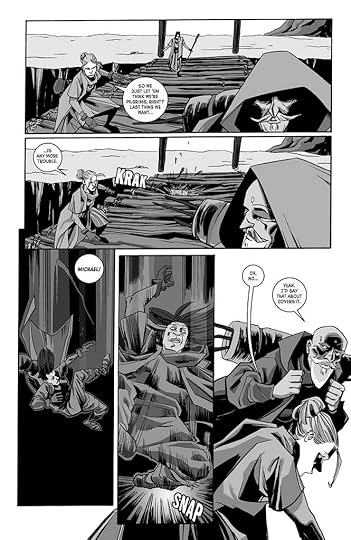
Find out more about WASTELAND (and discover the theme music) at thebigwet.com.
Related articles
Brubaker & Phillips' FATALE: A Preview (warrenellis.com)
Tomorrow's World: The Near Future Of Pop (warrenellis.com)
GUEST INFORMANT: Jim Rossignol (warrenellis.com)

GUEST INFORMANT: Joseph Stannard
Joe Stannard is a music journalist (I first noticed his excellent work in THE WIRE) and the curator of Brighton's monthly night of haunting, The Outer Church. I asked him to write to you a few days before David Bowie's birthday, and that's what was on his mind when he sat down to type:
As I write this, it's David Bowie's 65th birthday. Cue hilarious remarks about pensions, bus passes, etc and perhaps the odd comment concerning the fact that the erstwhile Thin White Duke hasn't released a new album in almost a decade. Me, I'm a fan, but I'm not holding my breath for a comeback. If Bowie chooses to spend the (hopefully long and happy) remainder of his life well away from the limelight, that's absolutely fine by me. And y'know what? If he does return, I won't be looking out for anything resembling Ziggy Stardust, or Aladdin Sane, or even the Duke. I'm more interested in the fellow who released an unexpectedly astonishing run of albums between 1993 and 2003. That's my Bowie.
And here's why.
In the late 80s, inspired by the Pixies, Sonic Youth and the New Sonic Architecture conjectured by the adventurous, forward-thinking music press of the time (I'm mainly talking about Melody Maker, incidentally, not the NME, dear me, no) Bowie assembled a rock group comprising guitarist Reeves Gabrels, drummer Hunt Sales and bassist Tony Sales. Derided as a rich man's folly and only sporadically any bloody good, Tin Machine nevertheless performed an important function for Bowie. While the music press sneered at what they took for the playing out of a midlife crisis, the artist himself was rediscovering the joys of spontaneity and collaboration. The catalyst this time – and there's always a catalyst with Bowie – was his new guitarist. I realised something interesting was taking place when I first heard the still-outstanding 'Baby Universal' – a single from Tin Machine's second album, released in 1991. Here, Gabrels's technique picks up where avant-guitarists Robert Fripp and Adrian Belew left off in the late 70s, howling like a jet engine for the duration of the track, which sped along on the kind of manic motorik Bowie hadn't touched since 1980's Scary Monsters (And Super Creeps).
Tin Machine was the beginning of a process through which Bowie looked back over his career to assess what had been lost during the 80s, and what could be recovered. The band had exorcised his rock 'n' roll demons for the moment, and a return to Ziggy-era glam would be both undignified and undesirable. It would be more befitting and potentially fruitful to recall the lessons he had learned while working with musicians and non-musicians such as Eno, Fripp and Belew. When he reunited with Let's Dance producer Nile Rodgers for 1993's Black Tie White Noise, it was something of a surprise to find the resulting album, whilst obviously influenced by contemporary urban pop, more reminiscent of the Eno era and its immediate aftermath. Tracks like 'Jump They Say', 'The Wedding', 'Pallas Athena' and the gleaming, chrome-plated cover of Scott Walker's 'Nite Flights' revealed a Bowie less interested in putting on his red shoes and dancing the blues than re-engaging with a future he had prematurely abandoned.
The Buddha Of Suburbia slipped out quietly in 1993, but offered still more striking evidence of Bowie's creative renaissance. Expanding on his soundtrack work for the BBC TV adaptation of Hanif Kureishi's novel, Buddha boasted bittersweet balladry, avant-jazz experimentation and Kraut-ish electronic buzzpop as well as Bowie's first substantial forays into beatless ambience since "Heroes". When I first heard this record, I had just developed a taste for the bathyspheric sounds of 70s Eno, Can and Sylvian & Czukay, and tracks like 'Ian Fish, UK Heir' and 'South Horizon' blew my mind. How could an artist rediscover his muse so dramatically, almost 20 years after the fact – especially when the largely empty spectacle (give or take the odd great song, like his theme for the 1986 animated version of Raymond Briggs's When The Wind Blows) of his 80s career had left him a laughing stock? Fans such as myself, who appreciated his 70s glam racket for its tunes and flamboyance but were revolutionised by contact with the Berlin trilogy, found their hero restored after a decade in the glossy wilderness.
It was only a matter of time until Brian Eno re-entered the picture, which he did as producer of 1995's audacious 1.Outside, the opening installment of an as-yet-unfinished neo-gothic dystopian hypercycle centered around the grisly intersection between murder and art. It really can't be stressed enough that if you were too young to have witnessed Ziggy's demise or the Berlin rebirth first hand and had become used to the sensible, conservative Bowie of the 80s, this gloriously gaudy, bloodthirsty exercise in mock-schlock industrial rock constituted an enormous jolt. But, confounding expectation, 1.Outside didn't sound like the Berlin trilogy, nor indeed much like anything else in Bowie's back catalogue. The influence of future tourmates Nine Inch Nails could be heard in the punishing machine beats and tortuously processed guitar of 'Hello Spaceboy' and 'The Heart's Filthy Lesson' while the improvisations of pianist Mike Garson (last heard on 1973's Aladdin Sane) lent proceedings an unpredictable, maniacal edge. Mood-wise, it shared something of the dank futility of Diamond Dogs, but wrenched sideways into yet another possible future. Bowie's look at this point was just as striking as his music: gone were the stylish suits and immaculate coiffure in favour of a dyed-red spike cut, black eyeliner, bondage pants and tattered frock coat. Bowie became the Gallifreyan ambassador we deserved but knew we'd never get, a true leper messiah and a welcome riposte to the dimwitted flag-waving undertaken by the imbeciles of Britpop.
Having successfully re-established himself as a live act, Bowie set about recording what might just be his most divisive album to date. His first wholly digital recording, 1997's Earthling incorporated a big, bloody chunk of Drum & Bass alongside moves mimicked from Underworld and The Prodigy. Songs like 'Telling Lies' – arguably the first ever downloadable single from a mainstream artist, with remixes by A Guy Called Gerald and Adam F – and 'Little Wonder' were constructed upon lightspeed syncopations built from samples of Zac Alford's live percussion. Many sneered at the idea of a fifty-year-old demonstrating his love of Jungle, but the album stands up remarkably well fifteen years later. I have a particular fondness for 'Looking For Satellites', 'Dead Man Walking', 'The Last Thing You Should Do' and 'The Law (Earthling's On Fire)', which find then-voguish influences colliding with Bowie's signature songcraft to create something engaging, unusual and defiantly futuristic. Lyrically, the songs communicated a playful, plaintive English melancholia, evoking Syd Barrett and, again, Doctor Who – the most English alien of all time, with the possible exception of The Man Who Fell To Earth's Thomas Newton. To these ears, Earthling is too weird to have significantly dated. For what it's worth, it's the Bowie album I return to most frequently.
The three albums that followed Earthling weren't as batshit bizarre, but each had its merits. 1999's Hours… encased the bittersweet balladry of Hunky Dory within an airtight, uber-slick production yet sounded like the most natural and relaxed Bowie album in years, intimations of mortality and regret notwithstanding. 'Seven', 'Thursday's Child' and 'Survive' were standouts, rueful reminiscences which at least sounded heartfelt, even if Bowie was, once again, indulging in his customary roleplaying, while 'Something In The Air' shamelessly plundered its ring-modulated vox and climactic descending chord sequence from Annette Peacock's gut-crunching 1972 jazz-rock confessional 'I'm The One'. Despite a couple of unimpressive 'rockist' moments, Hours… was a graceful, understated record, tinged with sadness. 2002's Heathen welcomed back 70s collaborator Tony Visconti – an underrated factor in the brilliance of Low, "Heroes" and Lodger among others – to produce a set of songs which, like Hours…, suggested that Bowie had found himself at last… or at least arrived at a satisfactory facsimile of his 'true' persona. It was a slightly bolder album than its predecessor, bookended by two songs, 'Sunday' and 'Heathen (The Rays)', which occupy their own solemn space within the oeuvre, neither rock nor ambient, effectively haunted by both. Bowie's voice on Heathen was perhaps the best it's ever been, rich, sonorous and romantic. His final album to date, 2003's Reality, sounded like the work of a man with little left to prove, and it's my least favourite of the post-Tin Machine releases. Given the strength of its predecessors, however, that's hardly damning, and it was also blessed with one of his finest songs, 'The Loneliest Guy'. Elegiac barely covers it – just recalling its beatless, oceanic swell and devastatingly bereft lyric ("Steam under floor/Shards by the mirror's frame/Clouds green and low/No sign, no nothing now/But I'm the luckiest guy/Not the loneliest guy") brings a lump to my throat. It's the unsettling sound of the emotional entropy awaiting us all.
Since then, there has been little in the way of new recorded output save a few guest appearances here and there. Bowie's been spotted leading a relatively normal life in New York – the life of a father and husband. Given his legacy, and the unexpected manner in which he rallied and returned to full strength as an artist between 1993 and 2003 – not to mention his recent health issues – who can begrudge him? A recent (possibly fake) tweet intimated that a return to the studio may be on the cards, inspired by his newly notorious contemporary, Lou Reed (now of Lou Reed & Metallica, apparently). But if this comes to naught, I won't shed a tear. Naught is precisely what he owes us, after all.
Many happy returns, Mr Jones. Or not. It's your call.
The next Outer Church night in Brighton happens on January 20th.
January 5, 2012
SPEKTRMODULE 04
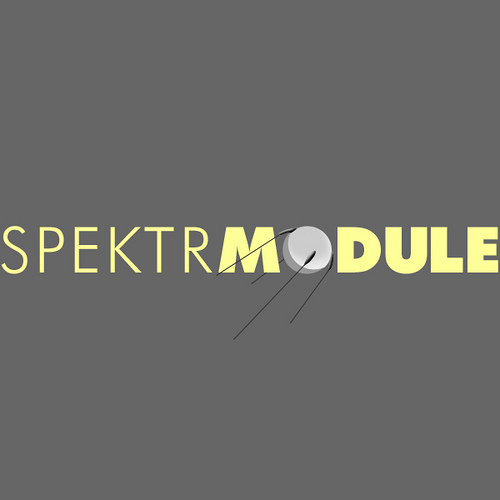
SPEKTRMODULE
04
Long Count
40 minutes and 6 seconds
Direct mp3 link. Press Play on the player then find the menu button in the bottom left for other functions. iTunes link.
@warrenellis / warrenellis@gmail.com
A gentle thing for the new year.
1. logotone
2. "Jenny" - Madam Bovary (album: Before the End Something is Coming to an End)
3. Me, wandering around the house speaking over a bluetooth mic. Terrible sound quality. I like it.
4. "flötenmenschen 4" – Dom (album: "edge of time")
5. "Regent In Burlap" - Hyaena Fierling Reich (album: Kalahest)
6. "Spirits" - OUROBONIC PLAGUE (album: SPIRITS /// GREMLINS)
7. Me again.
8. "No Drums" – Tim Hecker (album: Ravedeath, 1972)
9. "Hollow" - Birds Of Passage (album: Winter Lady)
10. "An Expected Future Event" - Talons (album: Hollow Realm)
11. "Calm" - Jon Porras (album: Undercurrent)
12. Me once more, slightly drunk in front of the tv over Xmas
13. "The Ongoing Significance Of Steel And Flesh" - Powell (EP: The Ongoing Significance Of Steel And Flesh)
14. "Tonight Is The Last Night Of The World" – Leyland Kirby (album: Sadly, The Future Is No Longer What It Was)
15. logotone
PREVIOUSLY: 1 – Fire Axes In Space | 2 – The Lane | 3 – Comfort And Joy
GUEST INFORMANT: Brandon Graham
I asked him to write to you about the process of making PROPHET, and this is what he said:
I feel like one of the big fights for anyone making a living off of art is the fight to be able to make the coolest work you can make.
I feel like comic books should be the front lines in this fight.
There's no real money in comics and all the real attention is on other mediums.
We should be rubbing our hands together and grinning like a couple of kids whose parents have just left town.
Like "oh shit, what can we get away with now?"
But it's still a big fight to get the work you're really excited about onto shelves. And past that, convincing someone to pay you to do the work that you are most excited about is more than a trick, it's a fucking scam of a magic trick.
So watch me pull a Prophet out of my hat.
I'm getting allowed to take this 90′s character and run with it, around the moon and try to slingshot back to make something as cool as the sci fi & fantasy that I grew up on.
One of the cool things about this project was being able to ask some like-minded comic dudes whose work I'm so excited about to collaborate with me on this. Simon Roy (Jan's Atomic Heart). Farel Dalrymple (Omega the Unknown) and Giannis Milonogiannis (Old City Blues.)
Since I come from doing comics as a one man show, I liked the idea of working with guys who are used to writing and drawing their books. So ideally we can approach this as less of a writer doing his part and and artists doing their part but more as a collective of comic book brains all working on the same ideas — throwing back and forth sketches and page layouts.
So we start out making an issue by talking it over while I write down notes. Then I wrote a breakdown that lists how many pages each scene should take. like –
3 pg: climbs up to a civilization of slaves that worship 15 foot tall crystal druids (who may have built the tower or may just be the oldest species to claim it) and working to fix the tower. hauling huge chunks of machinery around.
This is like working on a "what if" comic, trying to come up with the most fun and crazy ideas we can think of. There's a nice feeling of — can we get away with this idea? And as soon as you've said that you pretty much have to try.
Sometimes I do some layouts too. And heavy dialogue has to be planned out more than a fight scene. Simon did most of the layouts for the first issue and I did the 2nd, but mostly the guy drawing the issue does the layouts.
Here's an example of me and Simon hammering out layouts to get a page right. With Simon on the left and my reworking it on the right. This is Prophet working on a caravan shoveling the shit from one giant alien creature into another creature's mouth, until eventually what they've eaten can be processed into a material that the caravan of creatures travels around selling.
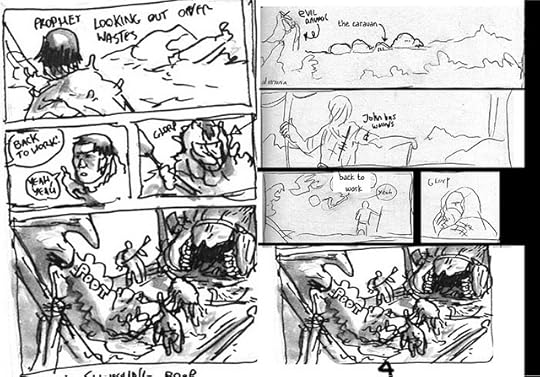
And then how the page looks after it's drawn with colors by Richard Ballermann. The creature has speakers that are wired to its brain so it yells at them to feed it faster.
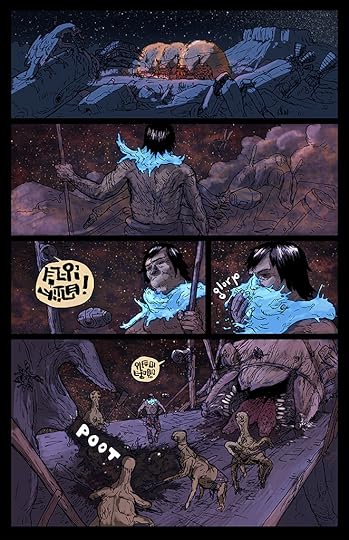
And then after it's all drawn I go back and look at my notes and write out a script for it. Then I send that to Simon and he sends it back with ideas on how it could be better. The goal is to keep each other on our toes and make sure that we're all making something that we're proud of.
Here's a poster I did to go in the back of our first issue (#21 on the cover)

Aside from Prophet I've still been working on my one man show comics as well.
This week I'm working on putting together the King City collection. I'm having a great time trying to think up fun ways to design the thing.
I just did these French flaps for the front and back of the book that when opened each have a character on a toilet — like the reader is opening a bathroom door without knocking. (rude dude) And I drew the spine of the book with a simple comic of a cat attacking a man and ripping out his spine.
Something I like about this golden era of scanning and print technology we live in is being able to throw in photos like the door knob Image logo on the spine and the tiny photo of my head on the bio/toilet flap.
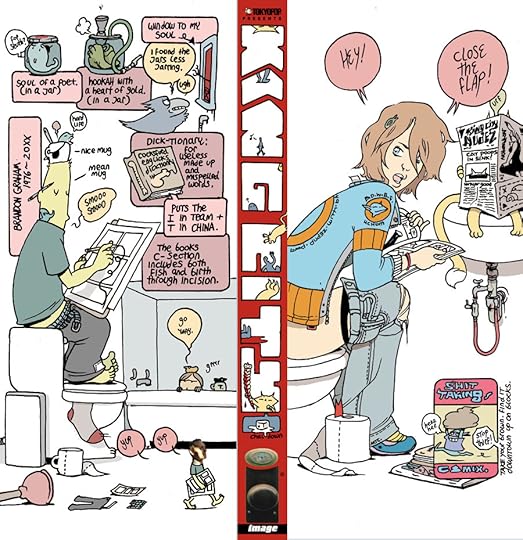
And totally unrelated here's a video of my pal Liz Greenfield reading her poem Cake — funny shit.
Thank you,
Brandon
Related articles
Five Predictions About The Immediate Future Of Comics (warrenellis.com)
The First Comic I Ever Loved (warrenellis.com)
Brubaker & Phillips' FATALE: A Preview (warrenellis.com)

January 4, 2012
Night Music: The Prescient Machine
Music inspired by the QUATERMASS tv series (which I've talked your ear off about many a time before), by Ian Holloway. Ian also does the world a favour by producing his occasional Wonderful Wooden Reasons online music review magazine, unearthing some of the stranger sounds you'll hear this year. Anyway, this is a properly alien piece of late-night atmospherics, very much befitting the source. G'night.
The Prescient Machine by Ian Holloway
Related articles
Broken20: BROKEN STRATEGY (warrenellis.com)
Night Music: Kristine Barrett (warrenellis.com)
GUEST INFORMANT: Colleen Nika (warrenellis.com)

Bookmarks for 2012-01-04
"Google+ is the new SEO. "
(tags:web )
Our tools don't make us who we are. We make tools because of who we are.
"Technologies change us, but we change the technologies, too. Technology is not an external force emerging from the very fabric of the universe (and, as you know, there are some Singularitypes out there who seriously believe that Moore's Law is woven into the laws of nature); our technologies (plural, lower-case T) are cultural constructs. They are artifacts of our minds, our norms and values, our societies."
(tags:tech )
Disruption Example: Open Source Protest + Flash Mob
"The Occupy Network/Brand is a perma protest against the future. ". interesting characterisation of Occupy, with many facets to it, some presumably unintended by the author.
(tags:pol war )
Five Predictions About The Immediate Future Of Comics

I should have titled this "non-predictions about comics in 2012."
Predictions are, by and large, a mug's game, and some if not all of what's below falls under the rubric of The Bleedin' Obvious, but I wanted to get it out of my head and down on a screen in any case.
This year should be the year where a wide swathe of established comics creators go "digital-first" with a broad variety of projects. However, that should also have been last year. Which leads me to wonder whether or not there's really a taste for it among the creative community. (Aside from me: but I'm not certain I'd have the time or access to the artists that'd really make it work for me.) So I'm going to go ahead and say this isn't going to happen this year, and won't until it's really too late – and just hope I'm completely wrong about this one.
This year, at least three groups will offer indie comics creators a "roll-your-own" digital service allowing them to ready and upload their own comics into storefront apps. It will be absolute chaos, and will create the sort of curational crisis you see when you browse for Kindle books by genre.
A corollary to the above, though: I expect to see more new comics creators bypassing the standard model of comics publishing entirely this year, and going straight to book publishing houses and crowdfunded self-publication and direct-to-digital using one of the services mentioned above.
For those who care about the big commercial comics companies: DC will continue to cede market share to Marvel during 2012, until they launch another round of issue 1s in September. But the bounce from that won't last as long as the New 52. At which point, sadly, I think we'll see the first signs of exits and exit strategies from DC staff.
More of this: Oni, Viz, Avatar, Boom, Archaia, Fantagraphics and a few actual publishing houses having less share in the direct market than Eaglemoss, a company that packages partwork magazines with little Marvel and DC character figurines. A less perfect illustration of what comics stores are actually interested in selling, I cannot find today.
January 3, 2012
FAQ
Decided to open an occasional section for questions. You can email queries to warrenellis@gmail.com and I'll get to them when possible. Let me start you off with the most frequently asked, most boring questions, usually coming from people who don't know how to use Google:
When will FELL return?
Ben has a script in hand, but he's had a really tough couple of years. He'll get to it when he gets to it, and then I'll write another one if he wants me to. Sorry. Real life here.
When will DESOLATION JONES return?
At this point? Probably never. Sorry.
When will NEWUNIVERSAL return?
It's been cancelled by Marvel, and Marvel, as was their privilege as my employer, moved me on to other things. As I was contracted to them, it wasn't productive for them to have me continue to try and reconstitute lost scripts.
What lost scripts?
(Brief version.) One day, a few years ago, my backups all got corrupted, and my backup device died. I didn't have online backups at the time. I'll fix that on Sunday, I thought, as I was under deadline pressure. Saturday evening, my main machine died in flames. Sent it off for data recovery. The guy running the data recovery shop took it in and then went off to Europe for an operation. And died on the operating table. Came back to the shop to get my machine, because no-one was answering the phone, to find it boarded up, the (mostly off-the-books, apparently) employees scattered to the four winds, and the shop stripped down to the plaster. Not a computer left in there — not even mine. I lost everything, all notes and scripts for work in progress as well as the entire archive.
(And no-one could do anything with the fucked backup discs, either.)
What happened to LISTENER, the book you have been listed on Amazon as writing?
Dead project. I've since changed publishers. My next novel is GUN MACHINE, out this autumn from Mulholland Books.
When will ANNA MERCURY 2 and DOKTOR SLEEPLESS be completed?
I'm halfway through the double-sized final issue of ANNA MERCURY 2, so, I expect you'll see that by summer. DOKTOR SLEEPLESS will, I hope, reach the same kind of conclusion by the end of 2012. Maybe December, for the hell of it.
Related articles
GUEST INFORMANT: Matthew Sheret (warrenellis.com)
Who I Am And Where I Am (Dec 2011) (warrenellis.com)

Bookmarks for 2012-01-02
"When Foreign Policy asked the International Crisis Group to evaluate which manmade disasters could explode in the coming year, we put our heads together and came up with 10 crisis areas that warrant particular concern."
(tags:war pol )
Urbanism and the Graphic Novel: Frans Masereel's Die Stadt (The City)
"With a quote by Walt Whitman, Belgian graphic artist Frans Masereel unveils "The City: A vision in woodcuts." Masereel, who became known for his pacifist anarchism, achieved with this 1925 woodcut series an uncanny precursor to the modern graphic novel."
(tags:comics )
And Then I Drank Crystal Head Vodka

I got this for Xmas. It's actually a surprisingly nice drop, with a very schnapps-y finish to it at room temperature. Probably from whatever lethal impurities lurk in the Herkimer diamond they filter it through. I intend to chill it down and extract a vodka martini from it later.
Things achieved so far this week include:
Writing a blurb for the back cover of the forthcoming reprint of Howard Chaykin's SHADOW comics series. Writing one long and two short emails to BERG that probably made them want to kill me. Receiving one short message from Patton Oswalt that suggests he wants me to kill myself. Receiving a smoke signal from that nice Mr Whedon. And deciding I'm not going to do the GUN MACHINE revision until next week. I am bruised and convalescent. Good morning.
Warren Ellis's Blog
- Warren Ellis's profile
- 5768 followers



